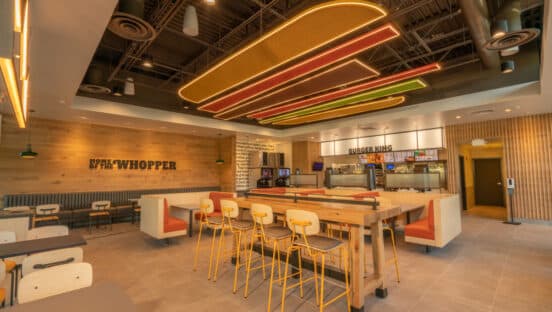Over nearly 50 years, Carrols Restaurant Group became Burger King’s biggest franchisee at more than 1,000 locations nationwide. It operates about 15 percent of the chain’s U.S. footprint.
Don’t expect that to happen again, at least not in the foreseeable future.
On Tuesday, Burger King announced plans to acquire Carrols for $1 billion, with two key purposes in mind—use $500 million to accelerate the pace of 600 remodels, and refranchise stores over the next five years. Keep in mind, this is a group of locations that reported same-store sales increases of 7.2 percent in Q4, year-over-year. The restaurants also saw a 2.9 percent uptick in traffic and a 140 percent jump in profitability compared to the year-ago period. Overall, Carrols’ total restaurant sales rose 8.4 percent to $1.88 billion compared to $1.73 billion in the full year of 2022.
The two-pronged plan of remodels and refranchising speaks to parent company Restaurant Brands International’s new leadership team’s emphasis on building franchisee profitability across the system. The idea is to hand these high-performing, modernized restaurants to franchisees with smaller portfolios who live in their communities. In fact, Burger King’s new preference is for operators to have no more than 50 stores. The chain currently has 300 franchisees, but that is expected to move to roughly 400–500 in the next few years.
“This is a clear demonstration of our strategy at work,” said RBI chairman Patrick Doyle. “We told you we need every Burger King in the U.S. to be modern and competitive, and we told you that we need strong local operators, not just owners running our restaurants. This accelerates progress on both of our objectives. Second, we’re going to turn around Burger King U.S. and position it for years of growth and success.”
“You can question how much money it might ultimately cost and you can question how fast we’re going to do it,” he adds. “But with this acquisition, I hope that you will no longer question if we will be successful. I am completely confident that we will.”
Burger King didn’t put limits on whom it will sell these restaurants to. They could be new or existing franchisees or ones with multiple brands in their portfolio. The emphasis is that they’re “operators who live in the communities restaurants serve,” said Tom Curtis, president of U.S. and Canada. And that’s because Burger King leaders “typically see the smaller franchisees living locally perform well.”
The transaction should provide additional career opportunities, including long-term Carrols managers who may want to become franchisees.
“We’re building that pipeline of operators that could come internally, that could come from our corporate teams, and also could come from other restaurant concepts if they’re proven operators,” Curtis said.
However, Curtis noted not all large operators will be excluded. Smaller entrepreneurs will just be the prevailing preference.
“That’s certainly the direction that we want to go in,” Curtis said. “But I do want to point out that we have some larger operators that are extremely accomplished, and they’re producing great experiences for their guests and team members. And so there’s certainly no need to call that [50 units] as the absolute target. It really comes down to the operators’ capabilities to run great restaurants and provide great guest experiences to invest back into their business so that we have restaurants that we’re proud of. And to the extent that any operator is capable of doing that, they’re welcome to be part of our business.”
All of it circles back to Burger King’s $400 million Reclaim the Flame plan, first announced in September 2022. With an investment alongside franchisees, the system will remodel 800 restaurants into a modern image and refresh 4,000 stores with technology, kitchen equipment, and building enhancements, by the end of 2024. Operators are buying in, with 96 percent signing up for the plan. Being the largest operator, Carrols has been a significant part of the strategy. The franchisee debuted Sizzle, Burger King’s newest prototype equipped with kiosks and mobile ordering pickup in the dining room and at the drive-thru. Carrols hoped to bring kiosks to 250 or so restaurants in the next few months, with most of it funded by Burger King’s Reclaim the Flame strategy.
The comeback framework is also about rooting out underperforming operators. Last year, three big franchisees—172-unit Premier Kings, 120-unit Meridian Restaurants Unlimited, and 90-unit TOMS King—all declared bankruptcy. Many stores shuttered and others were sold to fellow franchisees and Burger King corporate. During the Q1 2023 earnings call, the company estimated that 300-400 U.S. restaurants would close in 2023. After entering the year with more than 7,000 domestic units, the fast-food brand ended Q3 at 6,864 stores. That’s the lowest the U.S. system has been in decades.
“You should all take away that we are willing to do what it takes to set this brand system and its franchisees up for the long term,” Doyle said. “Last year that included helping some large franchisees to exit the system, knowing it required tough conversations and would result in some ugly headlines. At the same time, we’re fully invested in the success of the majority of our franchisees who are dedicated and working hard to give customers great food and great service.”
Burger King paid $9.55 per share for the publicly traded Carrols, which represents a 23.1 percent premium of the franchisee’s 30-day average stock price as of January 12. The purchase is expected to close in the second quarter. The company is financing the transaction with cash on hand and $750 million of incremental financing led by JP Morgan.
Carrols owns 1,022 Burger King stores in 23 states and 60 Popeyes units in six states.









